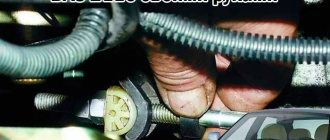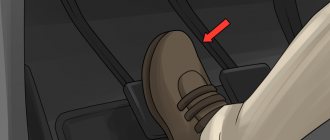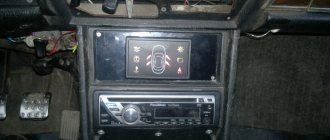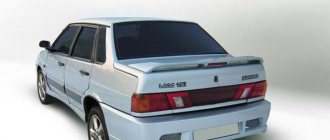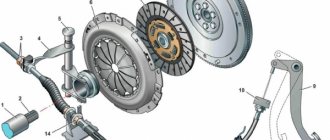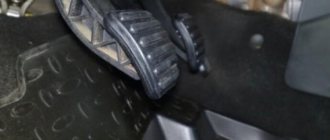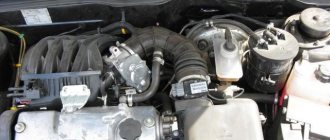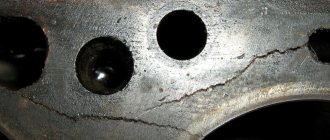The importance of proper operation of the friction clutch is difficult to overestimate - it is not only a smooth ride, but also the effective use of the vehicle’s traction power. adjusting the transmission clutch does not always lead to the desired result, and you have to change the discs of the torque transmission mechanism. This is not to say that such repairs are completely simple, but the first thing that matters is the selection of the part, so a review of popular kits will come in handy.
Why do you need a clutch?
Requests for the design and replacement of an auto component come from owners of Soviet and Russian Zhiguli cars, since the part has long been worn out by default, even under the most gentle operating conditions. The clutch is an important component of a car's performance. The unit is installed in cars with manual transmissions, where it is required.
To understand the importance of clutch, you need to remember why the car moves in the first place. The wheel torque is obtained from an internal combustion engine. But not directly, but through a complex chain of mechanisms. A simplified diagram looks like this: internal combustion engine-transmission-wheels.
But between the engine and the gearbox there is a clutch. One side of it is attached to the engine flywheel, the other - to the gearbox shaft. To connect two key units - power and transmission - the VAZ-2110 uses a clutch. However, it not only connects the motor to the gearbox (transmits the power flow), but also briefly, at the right moment, disconnects them - interrupts the rotational energy.
The transmission of torque between the internal combustion engine and the gearbox occurs when the discs with friction linings are pressed against each other - at this time the mechanism is inactive, that is, the pedal is not pressed. If the driver presses the pedal to the floor, the clutch disconnects the plates of the units: this moment is used to switch to another gear.
Clutch pedal
Thus, two main clutch functions have been identified:
- Transmit torque from the engine to the gearbox.
- Briefly disconnect the engine from the gearbox when the driver, having reached the required number of engine revolutions, wants to speed up or slow down the car - go to another stage.
The tasks of the clutch also include: smooth gear shifting, damping torsional vibrations from the engine.
Do-it-yourself tuning of the VAZ 2107 gearbox, modernization of the rear axle of the VAZ 2105, modification of the VAZ 2104, VAZ 2105, VAZ 2107. Tuning is a change and modification of the factory settings of the car. Tuning a VAZ with your own hands is a labor-intensive task, so we decided to share some instructions for modifying a VAZ 2104. Tuning can be cheap and expensive, superficial and deep. The modification of the VAZ 2107 is considered in sections: interior tuning, suspension and steering tuning, braking system and body tuning, as well as engine tuning and gearbox tuning. First of all, when tuning a VAZ 2105, you should pay attention to the ignition system. The classic is a popular car that provides its owner with a wide range of tuning and modifications.
It’s been a while since I “sharpened my teeth” on the clutch... After an hour of jerking in traffic jams, my left leg got tired and I began to regularly underpress the pedal, while the crunching sound from the gearbox did not contribute to peace of mind. I wanted to reduce the effort on the pedals. I remembered an article about a modified seven (I don’t even remember where I found it), they installed a clutch slave cylinder from a GAZ-3102. The logic is simple - to reduce the force on the pedal, it is necessary to increase the internal diameter of the working cylinder (for the classic it is 19.05 mm, and for the Volga it is 25 mm). Searching for information on this topic did not yield anything - the most I could find out was that they do this and that the pedal really becomes softer and lighter, and for installation it is necessary to make a bracket. Since no information on installation was found, I decided to tackle the issue myself... A trip to the store ended with the purchase of a Volgov cylinder. Next came fitting, taking measurements and making the first version of the bracket. Looking ahead, I will say that I then remade it three times... In parallel with the manufacture of the bracket, I disassembled the cylinder. I was not pleased with its design... The piston is spring-loaded and is constantly in the extended position. If the spring is simply removed, the piston falls into a zone with an increased diameter, where it is simply ridiculous to talk about sealing the cuffs. If you install a thrust bushing inside, it will block the hole in the fitting for bleeding the system from air. In addition, the cylinder turned out to be much larger than the original one and it was problematic to place it. The dilemma seemed insoluble... During my next visit to the store, a working cylinder from an UAZ caught my eye. It was more compact and its piston was not spring-loaded; its internal diameter was 23.58 mm. Naturally, I bought it. Also, for experiments, I bought a classic cylinder (if it doesn’t work with the installation, just install a new part). I came across a product from Nagel. All three cylinders, for comparison. From left to right: GAZ, UAZ, classic.
I should note that the original rod is already screwed into the UAZ cylinder. Actually, he looks like this.
In my opinion, the design of the GAZ and UAZ cylinders has a significant advantage compared to the VAZ one - this is a boot in the form of a corrugation - such a boot should not tear as often as on the classic. Well, let's get down to business. First of all, the rod in the UAZ cylinder was disassembled (it’s a national team).
Next I disassembled the entire cylinder. The piston was removed and trimmed 3mm on each side. I did this because it initially has a smaller stroke than the classic one. The cylinder was then assembled - nothing else needs to be changed there. Now we need to install all this - we need a bracket. I practiced with this to my heart's content... The process went as follows: I make a bracket, try it on - it fits terribly, redo it, try it on... and so on three times. It was treated on the fourth... What problems arose: the rod works at an angle to the cylinder axis - there will be rapid wear of the cuffs, the steering gear pendulum rested against the cylinder when the steering wheel was twisted to the left, the cylinder is located close to the beam - you cannot connect the hose. As a result, we managed to find its optimal position and, accordingly, the optimal design of the bracket. The last option turned out to be prefabricated, and it is now on my car. Sketches of the assembled bracket and its parts. In addition, a new rod had to be made.
All this equipment is assembled with a cylinder.
I also made a new bracket for attaching the return spring of the VAZ 2104. I cut it with a jigsaw from a piece of 1 mm steel. Along the fold line, bend the eyelet 90°. The location of the fold line is not critical, which is why I do not give a size based on its location. In fact, I cut out the entire spring bracket “by eye,” so the sketch is quite conventional... I installed it between the bracket and the bar screwed to it.
Now the entire structure can be screwed to the car. In this case, you need to pay attention to the length of the bolts that will secure the bracket to the clutch housing. The top bolt is located directly against the flywheel ring gear and a long bolt will simply jam it. By the way, that’s what happened for me... And then I scratched my head for a long time: why doesn’t the starter turn... Thank God I didn’t break anything... So you need to take bolts approximately 20 mm long, and after screwing them in, try to turn the engine by the ratchet to make sure that nothing sticks. It's time to connect the cylinder to the hydraulics. It was then that it was discovered that it was still standing quite close to the beam and the clutch hose was difficult to place. I had to make an adapter to connect it at an angle and bring it to the side. The connection principle is similar to how the front brake hoses are connected to the working cylinders. Sketches of adapter and screw. Finished parts.
The adapter must be screwed, as usual, through copper washers.
All that remains is to screw everything onto the car. View of this entire farm.
After bleeding the clutch I started making adjustments. Here another ambush was discovered. Although I was expecting this... Due to the increased diameter of the cylinder, its stroke decreased and it was possible to adjust the clutch of the VAZ 2105 only by completely selecting the free stroke of the fork. The fact that this leads to the imminent demise of the squeezer, I think, does not need to be explained. To solve this, it is necessary to supply a larger volume of fluid to the cylinder, and this can be achieved by increasing the piston stroke of the master cylinder when pressing the pedal. I did the following: I tightened the clutch pedal adjusting bolt all the way and got decent free play. Then I machined a new master cylinder rod of increased length. I added 20 mm to its length, with the expectation that I would make the exact adjustment in the garage. After trying it on, I sawed off 14 mm. Thus, the new rod turned out to be 6 mm longer than the old one. After that I adjusted the pedal and readjusted the clutch. Now there was enough travel to adjust the free play of the fork.
I was pleased with the result of the installation - the pedal really became lighter and softer. When, after pumping, I pressed the pedal of the VAZ 2107, my first thought was: I pumped it poorly - the pedal failed... But no, the pedal just became much easier... I repeat once again - I’m happy with the result! I think it was not in vain that I spent so much time and effort on this!
How the clutch works
Fundamentally, the clutch design of a VAZ-2110 car looks like this:
- The engine flywheel is the drive disk.
- Driven disk (VD). Location - between the flywheel and clutch basket. The element, on both sides of which friction linings (FL) are installed, is connected to the gearbox input shaft by splines - the disc moves along them. The HP transmits force from the engine to the box. A spring shock absorber (damper) is inserted into the device body to dampen engine vibration.
- Clutch basket. This is a unit that combines a pressure plate and a diaphragm spring, which jointly act on the HP.
- Release bearing with release clutch.
- Mechanical (cable) drive.
- Clutch fork.
The design and principle of operation of the clutch
The vulnerable element of the clutch drive - the cable - may burst. Symptom of malfunction: the pedal falls without resistance and remains on the floor. If the clutch cable on a VAZ-2114 breaks, you need to stop the car, call a tow truck or tow it to the nearest service station.
However, experienced drivers can change gears on the go, without a clutch, and continue driving. Here you need to know at what speed to move the lever to “neutral” and move to a higher or lower level. Motorists without experience burn discs - repairing the clutch of a VAZ-2109 or 2114 costs a pretty penny, while changing the cable is easy.
Criteria: which clutch is better to install on a VAZ 2107 car of a classic design?
Based on the recommendations of experts and reviews from car enthusiasts, it is possible to draw up basic principles that must be taken into account when choosing parts for the gear shift control unit. In general terms, the picture resembles wheel alignment adjustment , when any useful recommendation greatly facilitates the process. In addition to the manufacturer's brand, when purchasing a driven disk, you should pay attention to the following factors:
- The plane of the friction linings must be uniform; during visual inspection, scuffs, cracks and chips are unacceptable.
- The presence of oil stains on the disc is strictly prohibited.
- Visually assess the quality of the rivet; the edge of each rivet must be the same; uneven riveting along the edges is unacceptable.
- The splines must be undamaged.
- Check that there is no play on the springs, dampers and linings. The presence of play indicates low-quality assembly of the unit.
A car enthusiast who is interested in which clutch is best to install on a classic VAZ 2107 should pay attention to the markings of the damper plate. Here is a logo made with a laser or hologram, which is an effective measure in the fight against counterfeit products.
Separately, it is worth considering the criteria for choosing a pressure plate for the classic VAZ “Seven”:
- To evaluate the quality of the basket casing, conscientious companies make them using the stamping method. The presence of deep scratches and cuts is a sign of a low-quality part.
- Inspect the quality of the riveting.
- Inspect the level of manufacturing of the cast disk and the machining of its mirror. The presence of microcracks, cavities and unevenness is unacceptable, and, conversely, an ideal surface indicates high-quality material and high-tech processing of the part.
Clutch kits VAZ 2108-2115
Manufacturers indicate the resource of the unit at 100-150 thousand kilometers. But the numbers are relative, the service life depends on the engine power, the materials of the unit, driving style: frequent slipping, sudden starts.
It is also worth checking the clutch on a VAZ-2110 or 2114 for oil contamination through the current seals of the box or engine. Therefore, your own maintenance of the VAZ-2110 clutch must be carried out regularly: experienced drivers recommend 30 thousand km on the speedometer.
Service is urgently required if the following symptoms appear:
- jerks at the start;
- when the clutch is released, the VAZ-2110 car jerks;
- Difficulty changing stages: clutch slipping and incomplete engagement are observed;
- characteristic crunching sound when changing gears;
- While driving, the car twitches, knocks, and when you press the pedal, the sounds intensify.
Burnt clutch
There are many reasons: the fork is deformed, the pressure plate is damaged, problems with the drive, friction linings are worn out or burnt, and the diaphragm springs are weakened.
When it comes to clutch discs, baskets, and friction linings, it is better to replace the units assembled, that is, buy ready-made clutch kits.
Engine 8 valves
The number of timing valves does not affect the choice of clutch kit. Nevertheless, some manufacturers mark it as “8kl”.
List of clutch kits for 8-valve engines from major manufacturers:
- VIS JSC. Article – 11183-1601000-00, price – from 3,395 rubles.
- Exedi Vis Rus LLC. Article – 11183-1601000-90, price – from 3,395 rubles.
- ASP MENSAN. Article – A00190B, price – from 2,665 rubles.
The clutch transmits torque from one shaft to another. By this element, drivers often mean the entire assembly. Therefore, “squeezed the clutch” and “squeezed the clutch” are the same thing for many.
Clutch disc kit for 8-valve engines
If we keep in mind the coupling as part of a single block, then its typical “diseases” are: slipping and not completely disconnecting. Therefore, checking the clutch of a VAZ-2110 car is a procedure with which the car owner should be familiar. Causes: unadjusted free play (rarely), oiling, worn friction linings.
Engine 16 valves
For 16-valve engines you can take the following clutch kits:
- Valeo-mag. Article – 801122, price – from 3,225 rubles.
- VIS JSC. Article – 21090-1601000-00, price – from 2,480 rubles.
- Article – KT 098552, price – from 3,160 rubles.
Valeo clutch kit
The kits are perfect for 8-valve VAZ 2108-2115 with a nuance for the “tenth” and “twelfth” models.
Posts 1 to 20 of 163
1 Topic by AlexeyG 2008-12-24 19:42:22 (2009-03-13 11:50:07 edited by maniboo)
- AlexeyG
- User
- Offline
- Registered: 2008-11-09
- Messages: 23
- Reputation: [ 0 | 0 ]
Topic: Clutch selection
It looks like the clutch is about to be replaced, there is a dip in 4th gear, periodically slips in 2nd, sometimes with interference on. transfers. I drive calmly and handle the clutch gently.
I don’t want to buy the factory kit, the reviews are not flattering about it.
A choice arose - to supply a cheaper kit - KRAFTTECH, or Valeo, LUK or SACHS.
I read a lot of reviews on the Internet, some say that the craft is a city, but it doesn’t go much in the region of 10-50 thousand km, some just squeak from it, about Valeo and other reviews are better, but you can easily run into a fake.
As I understand, the main problem with all current clutches is the release clutch.
And somehow 50 thousand is not enough for a clutch, although it is not known how the people who write about it drive.
Who will say what, who changed it, who installed what?
2 Reply from Driver 2008-12-24 19:57:35
- Driver
- User
- Offline
- Registered: 2008-12-08
- Messages: 460
- Reputation: [ 0 | 0 ]
Re: Clutch selection
They say SAX has good grip. Just be careful not to look at a fake. My car now has Kraft. Mostly I drive calmly, but sometimes I let the car go to shit. Once I set it on fire a little when I was dragging the “herring” up the mountain. The engine couldn't handle it and I had to play with the clutch a little. I don’t know how long the old owner drove it. I skated 50 thousand on it and have not yet found any signs of death.
3 Reply from AMX 2008-12-24 20:11:21
- AMX
- User
- Offline
- Registered: 2008-12-11
- Messages: 389
- Reputation: [ 0 | 0 ]
Re: Clutch selection
Craft - woof** +1. A friend put it on drain and it still spits.
Sachs (mine) - Very soft pedal - in traffic jams it’s just super, when compared with the same craft and VIS. But during dynamic driving it smells a little. It cost about 55 thousand. So far it’s normal, I think it’s enough for another 15 safely.
4 Reply from DAF 2008-12-24 20:11:55
- DAF
- User
- Offline
- Registered: 2008-11-19
- Messages: 33
- Reputation: [ 0 | 0 ]
Now I heard that the 2106 clutch will not fit
: to Niva. Allegedly, the difference is in the damper springs, due to which it will quickly fail. Is this true or some kind of scam? ++++P. dezh - see explanations above in the text. Just a fool, apparently. I want to sell the stale kit 21213, which no normal person can sell, at an inflated price - as a special “adapted” one for the Niva.
Only one thing is interesting - for whom was the FAQ created?
It makes sense not to bother yourself and figure out what goes where and how, but to install the assembled import kit.
then the 2121 basket was made (the same wide but with a stiffer diaphragm, the external difference is the hole between the blades) which was first used with the 2103 disk ++++Never. The driven disk has an index of 2121 or 2106.
and then with 21213. +++That’s right.
Accordingly, the clutch kits are 2101, 2103, 2121 and 21213.
True again. Just explain to me then how to explain the presence of wheels with narrow (29mm) linings on cars 21011, 2105,2104,21013, etc. with engines with a capacity of up to 1.5 liters, if since 1973 all VAZ classic pepelats with engines up to 2103 inclusive, according to factory documentation, are equipped with clutches 2103 - and wide (35 mm) linings for 2106, 21074, 2121, which, according to the same factory documentation, Are they equipped with a 2121 clutch?
: : It makes sense not to bother yourself and figure out what goes where and how, but to install the assembled import kit. : +++Not every import is a panacea. Not only are they crazy, but also some import baskets are much worse balanced. I’m silent about the disks - when I took the QH, I rejected two of the three presented ones - the linings were riveted in place. I’m not talking about release valves with plastic cases - that’s understandable. By the way, the Turkish parasha is also an import :)))
Source
